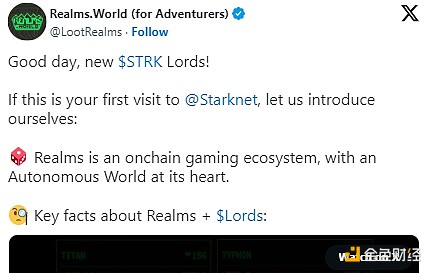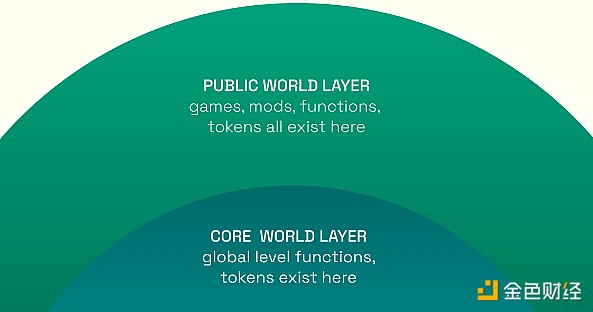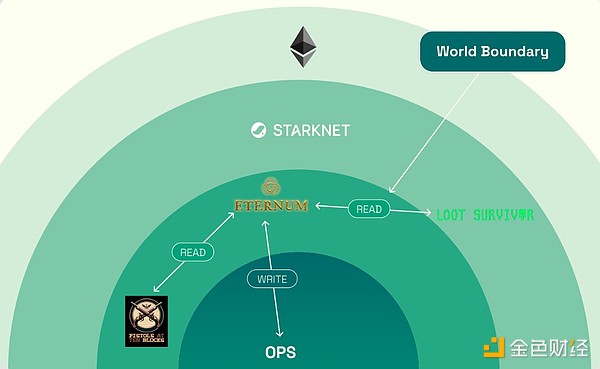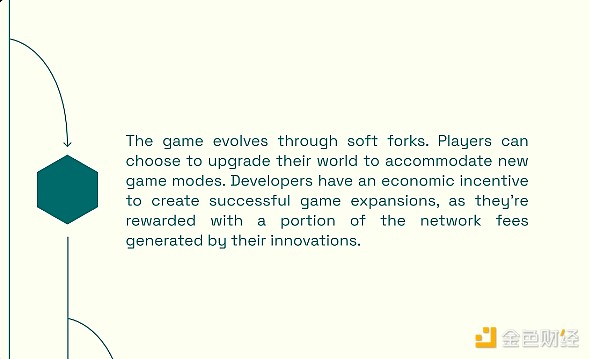Author: William M. Peaster, Bankless; Translator: Baishui, Golden Finance
Starknet has one of the most promising gaming scenes in crypto, and one of the most compelling emerging projects for me is Realms World.
Realms World is both a gaming multiverse and a custom autonomous world protocol on Starknet, the latter of which has a unique architecture designed to make this multiverse vision a reality.

The first game to be launched on this architecture will be Eternity, which I recently highlighted. However, Realms World will be an on-chain playground where Eternum, other Realms ecosystem games, and other non-Realms Starknet games like Influence can come together in unprecedented ways.
So now is a good time to take a look at what Realms World is preparing to launch once Eternum and the underlying protocol are about to launch. Below, let’s review the six main pillars of the project and why they are important.
1. $LORDS and veLORDS
At the heart of the Realms World economy is its native ERC-20 token $LORDS, which is used for nearly all transactions in the ecosystem, from trading resources to building in-game structures.
$LORDS also powers the veLORDS mechanism, through which players and developers can stake $LORDS to acquire veLORDS, granting them governance rights and a portion of transaction fees generated by the entire ecosystem. For example, a portion of $LORDS used for in-game auctions or trades is allocated to the veLORDS pool for liquidity and to fund future development.
In addition, $LORDS introduces monetization opportunities for alternative client interfaces. Developers can build custom web or mobile applications on top of the Realms World smart contracts, and these interfaces can then capture a portion of the transaction fees generated through their use, creating economic incentives for a great user experience.
Of course, on-chain gaming infrastructure like Realms is also poised to be used by an increasing number of AI players, so in the near future we may see automated agent-driven $LORDS activity become a notable aspect of the economic flywheel potential here.

2. Core layer and public layer
Another innovative element of Realms World is its two-tier architecture.

First, the Core Layer acts as the immutable foundation of the Realms ecosystem, hosting global standards and shared mechanisms such as the On-Chain Positioning System (OPS), a decentralized spatial mapping system for game assets. Changes to the Core Layer can only be implemented through governance votes, ensuring its integrity while allowing for adaptability over time.
Then on top of that is the Public Layer, a dynamic sandbox where developers can freely build without permission. This layer is where games, mods, and extensions coexist and interact using the standards established in the Core Layer. But developers can decide how deeply they want to integrate here, as they are free to innovate entirely new game mechanics as they see fit in the Public Layer.
3. Inter-game communication
Realms World’s two-tier architecture paves the way for interoperability, i.e. communication between games.
To be sure, some in the mainstream gaming and cryptocurrency space think that interoperable games are a silly thing to do. I would say that they lack imagination, and we have never seen anyone try this approach as seriously as Realms World is trying now.
In other words, Realms World is built from the ground up so that the ecosystem and its assets, mechanics, and state can be easily shared or referenced between games, creating an interconnected network of games.

Also, integration will be done at different levels, so not everything is always about interoperability.
Lightweight integration can involve shared tokens, allowing resources like $LORDS or NFTs to be used across multiple games. For example, resources mined in Eternum could be traded or used in a separate crafting-focused game. On the other hand, deeper integrations could go a step further by adopting gameplay mechanics or systems from another game entirely.
Either way, players will benefit from the freedom to carry assets and achievements across games, while developers will have access to a shared pool of tools, assets, and state to build on. Personally, I can’t wait to see the experiments here.
4. Modding, Seasons, and Soft Forks
Also of note is how Realms World’s public layer leaves its infrastructure and the experiences built on top of it completely open for customization and flexibility.
For example, think of modding. A developer could make a mod for Eternum that introduces naval warfare to leverage existing game mechanics while adding a unique layer of strategy. Then anyone who wants to use this mod can opt-in as they wish.
Another interesting element here is the season format, which will be used in Eternum but can also be used in other Realms World games. The system is set up so that each season runs by its own rules, paving the way for constant iteration of new features or game systems.
Finally, Realms World’s builders have adopted a “soft fork” approach to their protocol. Developers can create alternative versions of the Realms game, proposing changes or entirely new mechanics. Players will then be free to adopt or reject these forks, creating a meritocratic and creative environment where there are multiple experiences to choose from.

5. Open Economy
Another thing that I think will lead to a lot of clever experimentation is how Realms World embraces open economy principles, allowing for the integration of external currencies into its multiverse.
In other words, players can bring their own ERC-20 tokens from outside the ecosystem into Realms games, adding flexibility, expanding the range of economic possibilities, and letting players define in-game value with the assets of their choice, whether it's a stablecoin, a game currency that's being traded, or today's hot meme coins. This approach will allow Realms World to support cross-game marketplaces and other types of related applications.
6. STARKS’ FRACTAL SCALABILITY
Starknet is already performing well, to say the least. In a recent gaming stress test conducted by the Cartridge team, the network set a new L2 record with over 850 transactions per second (TPS).
That said, Realms World is lucky that Starknet can go even further. In addition to base layer optimizations, Starknet also holds the potential for fractal scalability, which is splitting transactions across multiple network shards so that Starknet can be fully relied upon when needed.
This approach will be particularly useful in facilitating the growth of the Realms World ecosystem as it grows. However, fractal scalability will also allow individual games within Realms World to scale independently. For example, Eternum could host thousands of players interacting in real time, while other games or mods can run simultaneously without affecting Eternum’s performance!
 JinseFinance
JinseFinance










